King Karl: The Man Behind The Dark Glasses
In 2005, EIC Kenneth Goh interviewed Karl Lagerfeld at the Chanel show in Tokyo. Here's a look back at what he had to say
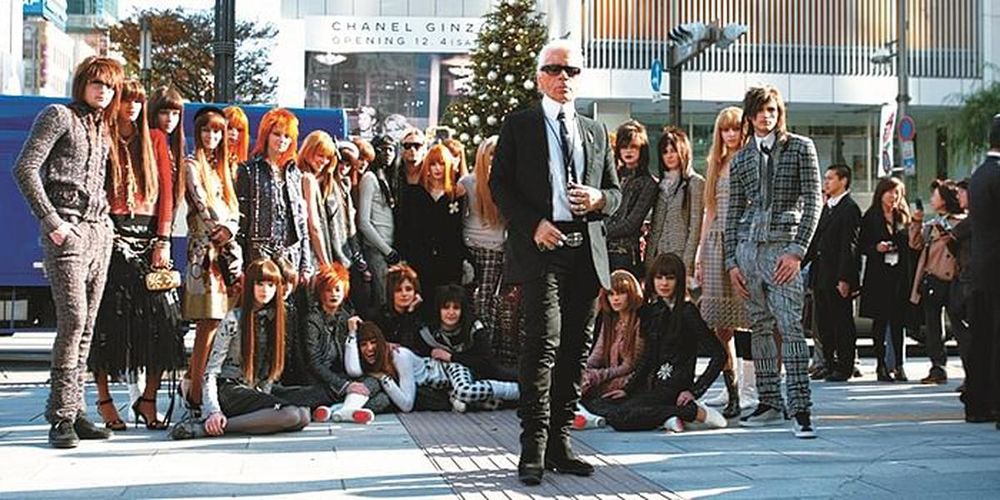
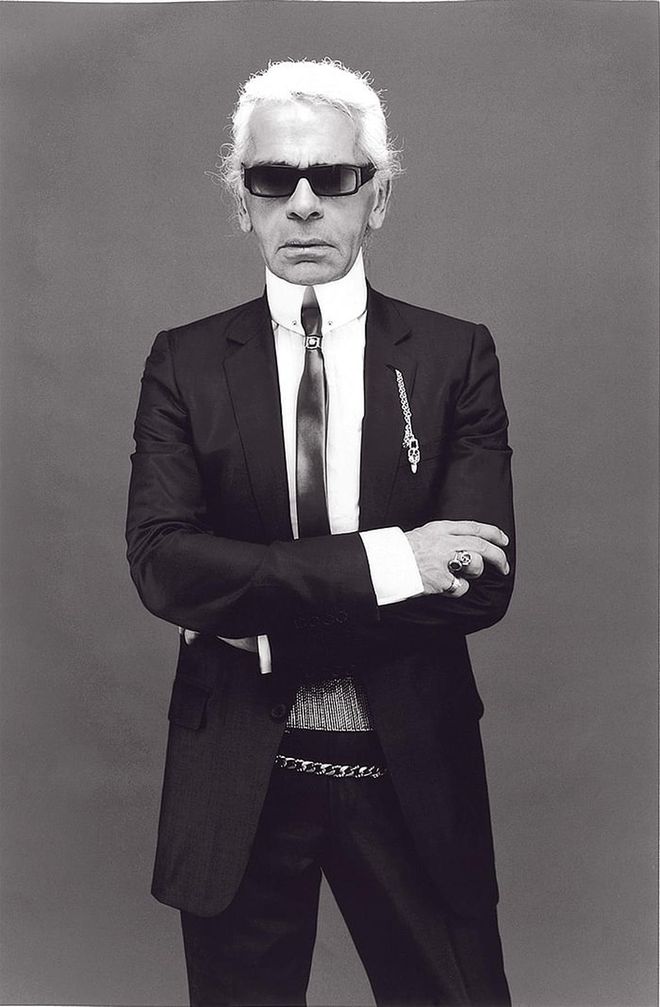
Lagerfeld’s self portrait taken in 2003
"Without glasses is worse than being naked; they are my portable eye shadow," so said Karl Lagerfeld some eight years ago. Today, that same man — called Kaiser Karl or Mr Puppet — still wears huge black shades, though he’s 42kg lighter in skin-tight Diesel jeans, a Dior Homme jacket, numerous Chrome heart rings and a high-collared white shirt. It’s his signature, like his acerbic wit, white powdered ponytail and haughty stance. Lagerfeld has never failed to impress, bewilder or amaze and he’s not going to stop. His inexhaustible energy is legendary and perhaps the reason for his astounding success. How else can one balance three fashion houses (Chanel, Fendi and his own, Lagerfeld Gallery); five homes in Monte Carlo, Paris, Rome, Brittany and New York; a flourishing photography career; and a voracious appetite, both as a book reader and an author?
So, when I had a chance meeting with the man some call “God” backstage, I was understandably nervous. He’s intimidating to say the least, and infamous for his biting comments. And woe betide anyone at the receiving end. He once called his archrival, Yves Saint Laurent, “... the top of boredom. He has been doing the same s**t for the past 20 years.”
There stood Lagerfeld, resplendent in his uniform, jazzed up with a long tartan Dior Homme kilt and high boots. Meeting Lagerfeld is akin to meeting royalty — you stand ramrod straight, hands outstretched and bow ever so slightly. He’s oblivious to the flurry of activity backstage — from assistants, stylists, music producers and models — and gives me his full attention. Clearly, he’s in a good mood. And so starts our interview — a casual chat with a doyenne of fashion, an icon à la mode. He’s a caricature of style; a pastiche of German precision and French savoir-faire. You can’t ignore his face full of make-up — it somehow suits him. It’s just another layer to this impenetrable enigma.

Lagerfeld’s sketches of Chanel accessories
ON CHANEL
What do you think of the Ginza Chanel building?
[American architect] Peter Marino did a beautiful building. Modern facade — but for the price they [at Chanel] pay, they better get something nice.
Would Coco have liked it?
It’s beyond her understanding. She’d probably be against it [laughs]. But it’s the only way to keep her name alive. Nobody knows [Elsa] Schiaparelli and [Madeleine] Vionnet anymore, whereas Chanel’s name is more well known worldwide than when she was alive. Her name is household because of the lipstick, her perfume, the building. I wouldn’t say it’s because of me. But eh ... [laughs]
Do you have a protégé?
No, no, no, not really.
Are you sad you don’t have one?
I couldn’t care less. Nobody can do it the way I do.
What would happen if you leave Chanel?
I don’t own the company. That’s not my problem.
You put men in Chanel jackets. Would you put them in Chanel skirts as well?
We don’t have to. Don’t forget, Chanel borrowed all the famous male elements — tweed, the cardigan and the pants. Also, what’s the difference between jeans, a T-shirt or a cardigan for girls and boys? It’s all the same. It depends on what you put into it and how you behave in it. Marlon Brando in a T-shirt is masculine and Coco Chanel in a T-shirt with a sautoir of pearls doesn’t look at all macho. It depends on what you do with the clothes. I think it’s fun because today girls and boys want to wear the same thing. But it’s not very honest if you design some things for men and of course, women can’t wear them. Besides, we only do them in small sizes because I don’t think they look good in big sizes. We stop at 48 [the equivalent of UK size 18] and if you don’t fit into that, then it’s not for you.
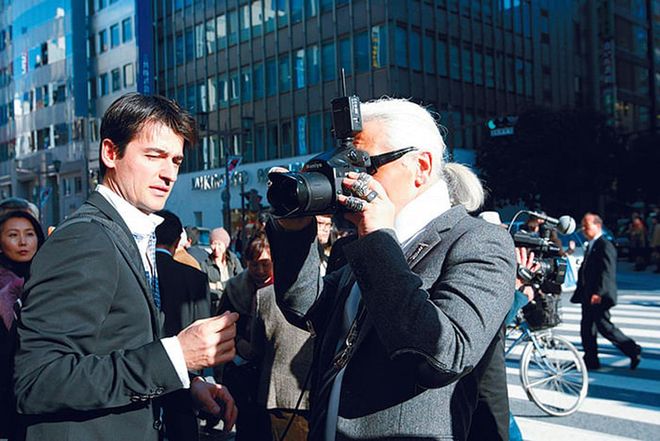
Lagerfeld taking pictures of the models on the streets of Tokyo
ON HIS SELLOUT H&M COLLECTION
Your collection for Swedish mass label H&M was a runaway success. Any comments?
The collection was supposed to last six weeks. But after 30 minutes, there was no more. I am very happy with the result. It’s not easy for someone to re-do it after the way it was done ... we did the ad campaign, the design, everything — it was a real package deal.
Have you bought anything from H&M?
I posed in some and they were gone; I never got anything. Even at work I don’t get anything. I have a few sweaters and a coat. The jeans they had made for me were too short — I couldn’t wear them.
Any other collaboration besides H&M?
No. This collaboration with H&M was a one night stand. I think one of the reasons they wanted me was their expansion plans into Japan and other parts of the world. They needed someone who was well known here to get credibility and visibility. It was not my fault!
You did some very good work for H&M, but you pulled out. What happened?
I designed for them what I think people could wear — for men, what I would wear; and for women, what I like. There’s one thing I told them they were not getting, and it’s Chanel. There’s enough fake Chanel at Zara.
ON KNOCK-OFF LABELS
You mentioned Zara. Is it a form of flattery?
What they do is very good, so we have to be even better in terms of material. If nobody copies you, you are dead. It’s a kind of compliment. One day I saw a beautiful Japanese girl who worked at Zara, and she had a coat that I thought was a [Chanel] coat from two seasons ago. I said she looked great and she replied, “You know, it’s Zara. I’m not paid enough to buy the real one.” It was exactly the same.
So you do think they do good reproductions?
People who buy Zara won’t buy the real thing, and people who buy the real thing may not buy from Zara. If you are copied, it means you are right.

Lagerfeld at work in his office, photographed in 1995
ON OTHER DESIGNERS
Are there any young designers you admire?
“Admire” is a strange word, you’re not supposed to admire. Competition is very healthy and needed. In the new generation, I like people such as Nicolas Ghesquière; I love what Tom Ford used to do. There are a lot of them, but I’m not a PR for other designers except those who are my friends.
So are you going to plug Dior Homme’s Hedi Slimane?
But Hedi is a men’s designer. We’ll wait for him to do dresses. He’s my favourite designer because I’m okay in his clothes and he’s a great person.
ON HIS PERSONAL STYLE
What’s your secret to great style?
Never buy something bigger; buy the smallest size.
Do you wear anything else besides Dior Homme?
Yes, I wear some Sandi Bertine but Dior Homme is best on me. I wear Diesel jeans. Libertine is good. I don’t look good in Chanel. I’m short-sighted and when I have no glasses and look in the mirror, I see my mother. I don’t want to be a bad copy of my mother. Also, I don’t like to wear what I design.
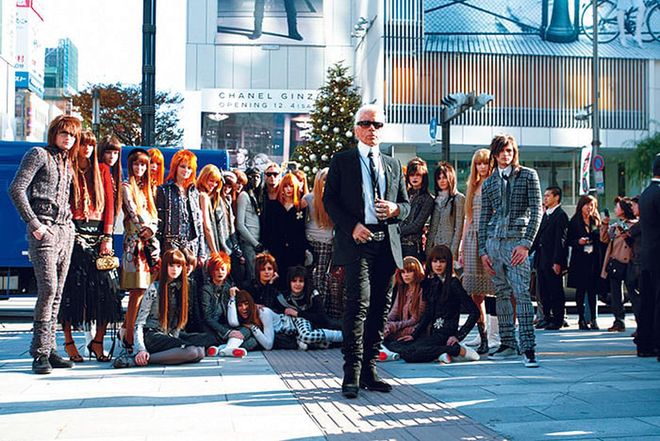
Lagerfeld and models outside the Ginza store
ON HIS PERSONAL LIFE
Why do you put on such an intimidating front?
You cannot ask that question because then I lose all spontaneity, if there’s any left. I don’t know ...
What is the most misunderstood public perception of you?
I couldn’t care less. I don’t try to understand so I don’t misunderstand.
Do you ever get tired?
Yes, when I’m not working or when I am bored.
How many hours do you clock in a day?
I don’t wear a watch. I sleep seven hours and wake up naturally. I never touch a drop of alcohol, never take drugs and never smoke. I think that helps, too.
Do you love making all these politically incorrect statements?
Yes, of course. It comes naturally. I never ask myself the questions; I just give the answers.
What is downtime for you?
I don’t know that word. I don’t want to know anything connected to “down” ... I’m only for “up”.
ON HIS MOTHER
You speak of your mother quite a lot. Was she an influence?
Only in terms of how to answer. The way she brought me up was very tough, but I think I needed that. I always admire her because she said the nastiest thing in the world, but said it in a certain way that sounded good for stupid children because I was a very pretentious child. I thought I was the centre of the world and everything had to be done for me, so somebody had to be there to give me a little downer.
Who casts a bigger shadow on you — Mademoiselle Chanel or your mother?
There are no shadows. Both helped me to become the sun, in a way. Mademoiselle Chanel is not a shadow; she does not influence me. I keep the candle lit, that’s all.
How would you describe your mood now?
I’m in a good mood, but I can be in a bad mood in five minutes from now. It depends. I’m a very moody person, but I know how to behave so it doesn’t show.
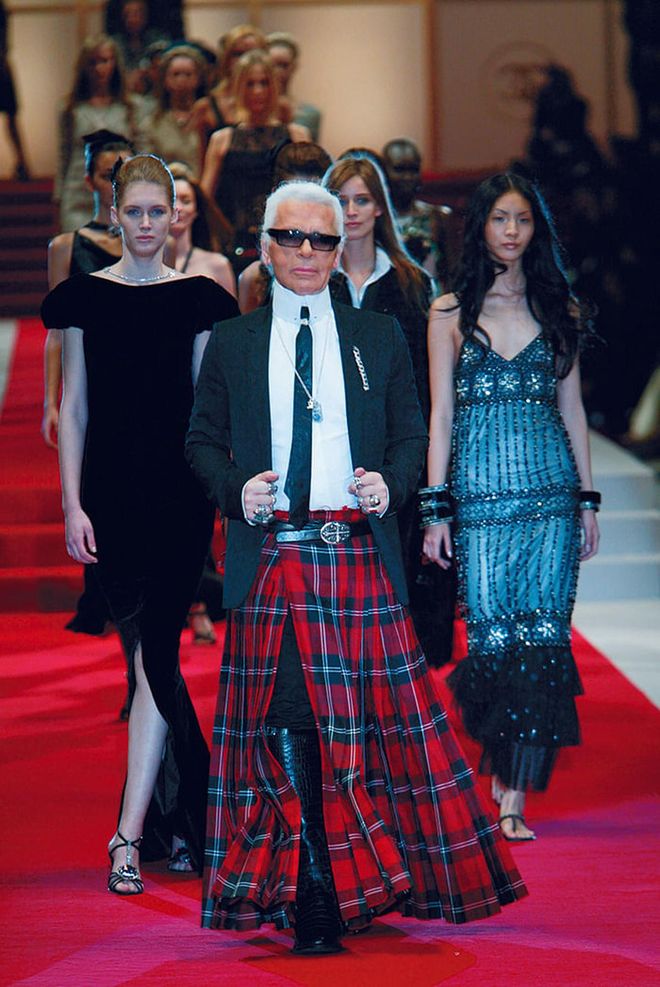
Karl Lagerfeld on the red carpet of the Chanel spring/summer 2005 Maxi show in the Hibiya Tent, Tokyo
Related articles
Karl Lagerfeld Has Died In Paris
Meet Virginie Viard, Karl Lagerfeld’s Successor At Chanel